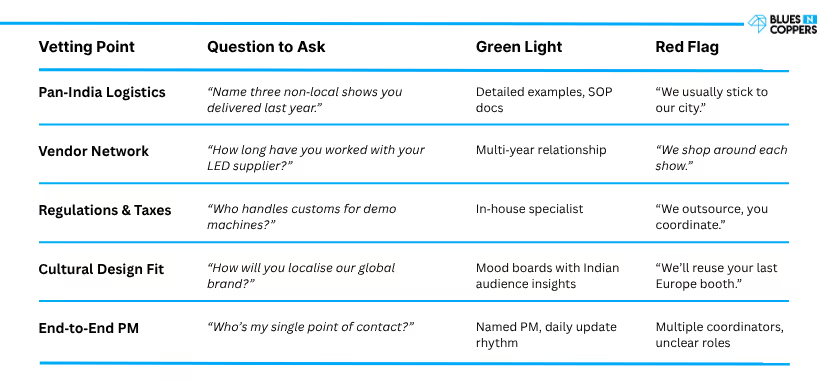India’s trade‑show scene is booming—fuelled by a fast‑growing economy, a huge buyer base, and a government push for industry‑specific expos across everything from manufacturing to MedTech. Yet for international marketing and event leaders, the promise of “Incredible India” can come with a dose of anxiety: unfamiliar regulations, tight timelines, hidden costs, and cultural nuances that are easy to misread from afar.
Good news: those risks melt away when you have the right local partner. This guide arms you with a clear, five‑point framework for vetting exhibition agencies in India, so your booth, your budget, and your brand all shine on show day—no surprises, no sleepless nights.
Why a Generic Approach Fails: The Non‑Negotiable Value of a Local Expert
India isn’t a single monolithic market—it’s a mosaic of regions, languages, and business cultures. A one‑size‑fits‑all playbook rarely works. A seasoned local partner helps you:
- Navigate regional dynamics. What works in Mumbai’s Bombay Exhibition Centre (BEC) may fall flat in Bengaluru or Hyderabad.
- Bridge cultural expectations. From design aesthetics to the negotiation style of vendors, local insight prevents unintentional missteps.
- Short‑circuit complexity. Permits, GST rules, and venue‑specific regulations are second nature to on‑ground experts.
Stat to remember: 64 % of exhibitors say the quality of attendees—not quantity—is the top reason they commit to a show. The right partner ensures your booth attracts the right crowd, not just foot traffic.
The Ultimate 5‑Point Checklist for Vetting Your Exhibition Partner in India
Think of each point as a filter. A partner who passes all five is worth your budget—and your trust.
#1. Pan‑India Logistical Mastery
India’s trade‑show calendar spans Mumbai, Delhi, Bengaluru, Chennai, Hyderabad, and more. Each hub comes with its quirks:
BEC, NESCO, and JIO World Centre in Mumbai are notorious for narrow loading bays and limited overnight work permits
Pragati Maidan in Delhi follows strict union rules on labour and overtime
BIEC in Bengaluru requires extended travel time for materials to arrive, which necessitates planning buffer days.
When it comes to your prospective partner, make sure to vet each one based on their experience. To be sure about your partner's capability, you want to understand the division of their deliveries both within the home city and outside. You want to make sure to look at some historic data of no more than two years.
If you have experience in participating in exhibitions, try to get a look at their preparedness based on their contingency plans. Look for specifics—names, timelines, and documented SOPs. Vague reassurances are a red flag (see our quick guide below).
#2. A Deeply‑Rooted Vendor & Supplier Network
A trusted agency lives or dies by its little black book of vendors: carpenters, LED suppliers, AV technicians, freight forwarders, and rigging crews.
Why it matters
- Quality control: Reliable vendors mean consistent material specs and finish.
- Cost efficiency: Long‑term relationships unlock better rates and priority service during peak show season.
- Risk mitigation: Backup suppliers are on call when Plan A hits a snag.
What to listen for
- Mentions of multi‑year partnerships, not one‑off hires.
- Examples of negotiating bulk discounts for multiple clients.
- Evidence they perform regular vendor audits (safety, quality, compliance).
#3. Expertise in Navigating Local Regulations & Taxes
From customs clearance to India’s Goods and Services Tax (GST), paperwork can stall a project faster than a forklift breakdown.
Checklist
Customs & ATA Carnet: Can they manage temporary import bonds and re‑export paperwork for demo goods?
On‑site permits: Do they secure structural stability certificates, fire NOCs, and electrical safety approvals on your behalf?
GST compliance: Do they provide proper e‑invoices and maintain a compliant chain of credit, so your finance team isn’t chasing rebates for months?
A partner who shrugs off regulations is not a partner—move on.
#4. Culturally‑Aware Design & Communication
A booth that wins awards in Frankfurt may feel sterile in Mumbai unless the visual language connects with local attendees.
Best practices
- Colour & motif: Draw on regionally resonant palettes (think rich hues and bold graphics) without sacrificing global brand consistency.
- Visitor journey: Indians often prefer open, welcoming spaces over closed‑off “VIP” zones.
- Messaging nuance: Avoid idioms or wordplay that don’t translate; lean on concise benefit statements.
Stat to remember: 46 % of attendees visit only *one* trade show a year. You have a single shot to make an impression—culturally relevant messaging maximises that opportunity.
#5. Proven End‑to‑End Project Management
Your ideal partner is a single‑point quarterback—from concept sketches to post‑show dismantle and storage.
Look for:
- Dedicated PM: One name, one phone number, 24/7 responsiveness.
- Cloud‑based tracking: Shared dashboards for timelines, designs, vendor POs, and on‑site checklists.
- Post‑show debrief: Data on lead count, visitor flow, and asset condition before items go into storage.
When this backbone is in place, you integrate seamlessly with wider campaigns—crucial since 76 % of exhibitors blend their trade show with other marketing channels.
Red Flags to Watch Out For
- Vague pricing or “everything included” quotes. Reputable agencies itemise materials, labour, logistics, and third‑party costs—no surprises later.
- Zero local portfolio. If they can’t point to at least a few recent builds at major Indian venues, caution lights should flash.
- Poor communication cadence. Long gaps between updates or evasive answers signal future chaos on site.
If you spot any of these, keep searching.
Your Partner Is Your Most Important Investment
Exhibiting in India can be transformative—new markets, fresh pipelines, and brand visibility in one of the world’s most dynamic economies. But success hinges on the partner you pick. Apply the five‑point checklist, watch for red flags, and you’ll turn complexity into a competitive edge.
Quick‑Reference Checklist

Keep this table handy—run it past every candidate, and choose the partner who answers with clarity and confidence.
Planning your next exhibition in India? Let our experience be your guide. Contact Blues N Coppers today for a no‑obligation consultation to discuss your vision. → \[contact page link]
FAQs
1. How far in advance should I secure an Indian exhibition partner?
Aim for at least six months out. Major venues like BEC (Mumbai) and Pragati Maidan (Delhi) book up quickly, and early engagement gives your partner time to optimise design, freight, and permits.
2. Do I need an ATA Carnet or a temporary import bond for demo equipment?
Yes—if you’re shipping high‑value products, you plan to re‑export. A seasoned partner will prepare the ATA Carnet paperwork (or arrange a bank‑guaranteed bond) and coordinate with Indian customs, so nothing languishes at the port or airport.
3. What’s the typical lead time for booth fabrication in India?
For a custom build, four to five weeks of shop‑floor production is normal, plus freight and on‑site installation (two to three days, depending on venue rules). Shorter timelines are possible, but they limit design options and raise costs.
4. How does GST work for foreign exhibitors?
Goods and Services Tax (GST) is applied to most local invoices. Your agency should issue compliant e‑invoices so you can claim applicable credits or refunds through your company’s Indian entity/ importer of record. Insist on transparent tax documentation up front.
6. Are there union‑labour or overtime restrictions I should know about?
Venues in Delhi and Mumbai enforce strict labour windows—usually 8 a.m. – 8 p.m.—with hefty surcharges for night shifts. A local partner pre‑books overtime slots, factors the costs into your estimate, and ensures crew badges and insurance are in place.
7. How can I gauge ROI beyond lead counts?
Blend pre‑show digital campaigns (email, paid social, retargeting) with QR‑coded touchpoints in the booth to track visitor journeys from first click to post‑show follow‑up. Your partner should integrate these metrics with your CRM so you see pipeline impact, not just footfall.

.svg)

.avif)


